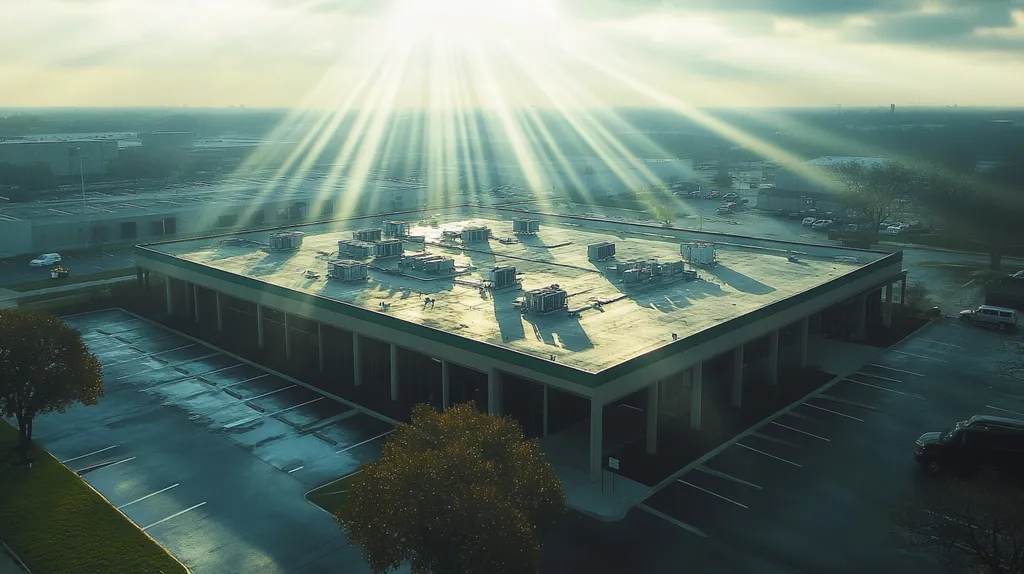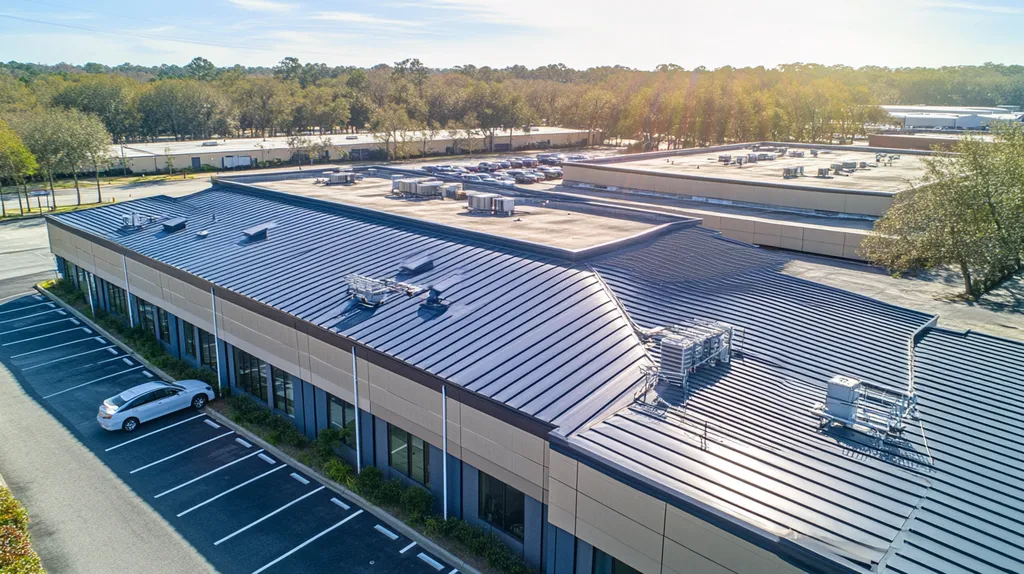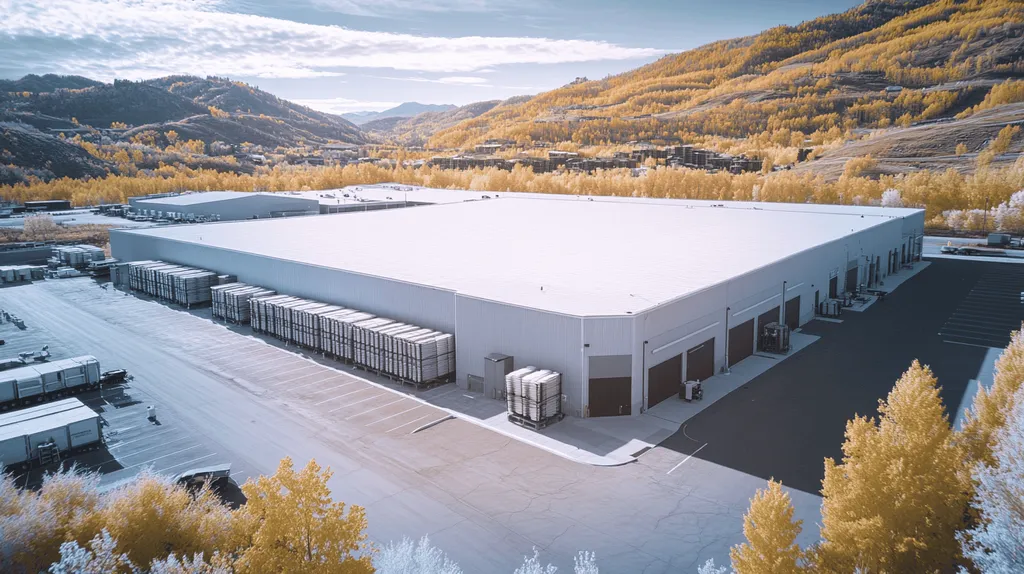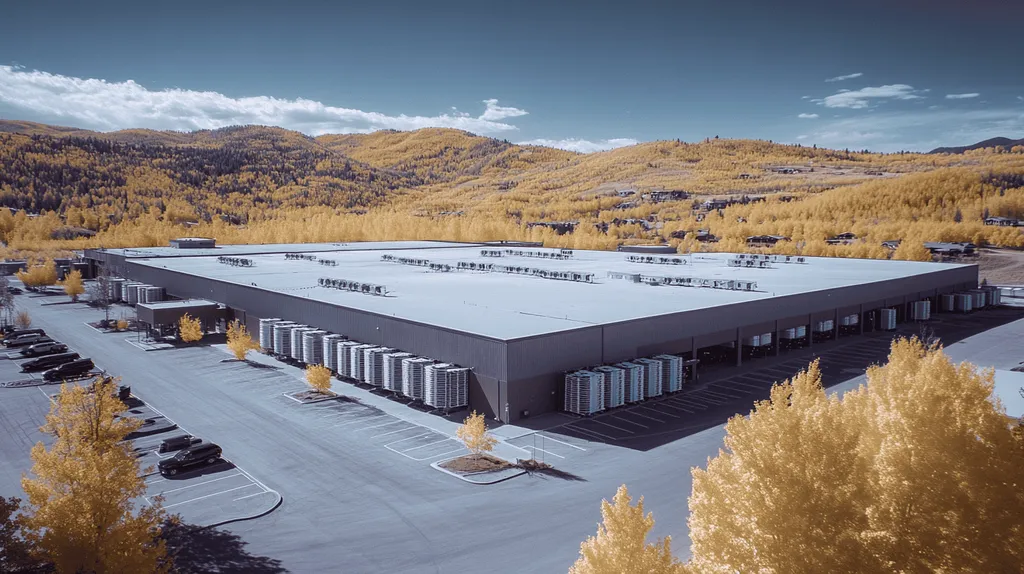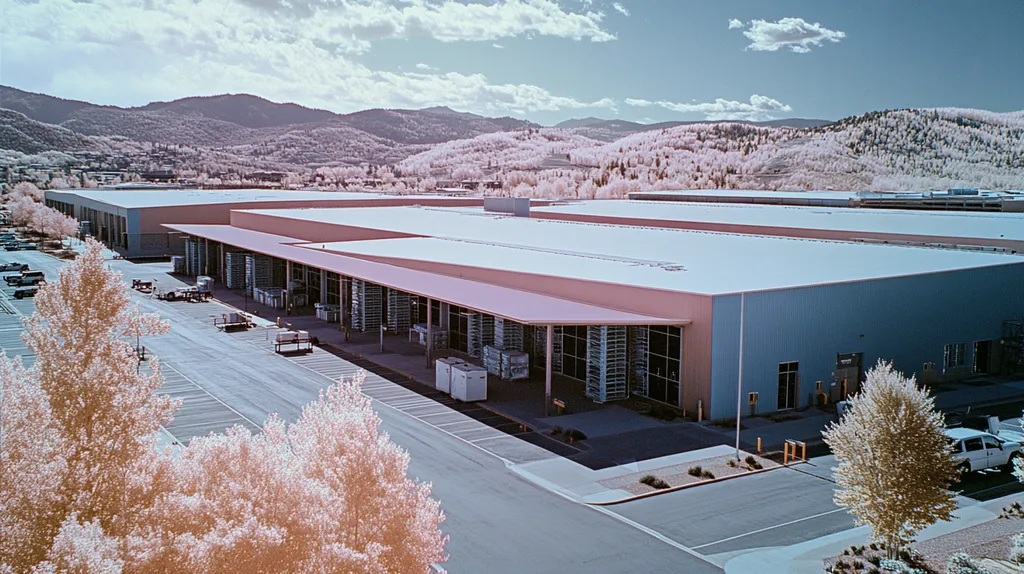Commercial property owners face a stark reality: roofs with high VOC content deteriorate up to 40% faster than their low-VOC counterparts, leading to premature failures and soaring replacement costs.
As environmental regulations tighten and building certification standards evolve, facility managers must navigate an increasingly complex landscape of VOC compliance requirements.
This comprehensive guide examines how VOC levels impact roof performance, maintenance demands, and overall lifespan while providing actionable solutions for property managers seeking to optimize their roofing investments.
SECTION 1: PERFORMANCE FACTORS
In today’s roofing landscape, facility managers need to consider the volatile organic compound (VOC) content in roofing materials seriously. High levels of VOCs can undermine a roof’s durability, leading to premature failures and rolling repair bills. Moreover, according to the Environmental Protection Agency, these compounds can negatively affect indoor air quality, making it essential to evaluate their presence in roofing products. This section dives into assessing VOC levels, how they impact roof coating durability, and the relationship between VOC content and roof lifespan.
Assessing VOC Levels in Roofing Materials
Facility managers should kick off their roofing assessments with a meticulous analysis of the VOC levels found in their materials. While manufacturers must provide VOC content data, the quality and accessibility of this information can be a mixed bag. Conducting tests before installation can uncover crucial insights that can safeguard long-term performance.
A consistent strategy for assessing VOC levels involves reviewing Environmental Product Declarations (EPDs) and Material Safety Data Sheets (MSDS). These critical documents often reveal detailed chemical profiles for roofing products and empower managers to make educated choices.
Additionally, partnering with suppliers who emphasize low-VOC options can help minimize harmful emissions. Cultivating relationships with trusted vendors streamlines the selection process and ensures compliance with local regulations.
Key Action Items
Impact of VOCs on Roof Coating Durability
The connection between VOC content and the durability of roof coatings is significant. Elevated VOC levels can precipitate rapid wear and tear on roofing materials, compromising their longevity and efficiency. For example, roofs with higher VOC content are more vulnerable to UV degradation and thermal expansion.
Research indicates that low-VOC coatings have a longer lifespan and reduce maintenance needs. Facility managers should actively seek coatings that meet or surpass industry standards for low VOCs to guarantee superior performance.
Furthermore, enhancing durability can lead to better energy efficiency. A well-maintained roof can result in lower heating and cooling bills, translating to a solid return on investment.
Key Action Items
Evaluating Roof Lifespan Relative to VOC Content
The lifespan of a commercial roof is intricately linked to its chemical makeup, especially VOC content. While high VOC products may offer short-term savings, they can lead to bigger costs down the road due to quicker failures.
For instance, a roof with low VOC content might better resist weathering and environmental stressors compared to its high-VOC peers. This relationship is vital for facility managers aiming to optimize the longevity of their roofing investments.
Regular inspections and assessments should be integral components of a comprehensive roof management plan. Monitoring degradation patterns can yield invaluable insights into how VOC levels affect lifespan and overall performance.
Key Action Items
SECTION 2: FINANCIAL CONSIDERATIONS
The financial stakes surrounding roofing decisions are higher than ever. With rising operational expenses and increasing environmental regulations, facility managers must prioritize low-VOC roofing options. While shifting to low-VOC materials may initially seem expensive, these decisions typically lead to significant long-term savings. Understanding the cost implications, budgeting for maintenance, and recognizing the benefits of extended roof lifespan are critical for making informed choices in commercial roofing.
Cost Implications of Low-VOC vs Conventional Roofs
At first glance, the initial expense of low-VOC roofing materials may appear steeper than that of traditional options. However, this upfront cost can be misleading. Conventional roofs often require more frequent repairs and replacements, translating into higher long-term expenses.
Low-VOC roofs, on the other hand, are crafted for durability and sustainability. By investing in these materials, facilities can expect fewer repairs and a diminished need for consistent replacements, leading to lower cumulative costs.
For example, a facility that adopts a low-VOC membrane could experience savings of up to 30% in overall roofing expenses over a 20-year period compared to conventional alternatives. These savings are not just from reduced maintenance but also from energy efficiency gains tied to improved insulation properties.
Key Action Items
Budgeting for VOC-Compliant Coating Maintenance
Strategic planning is essential when budgeting for low-VOC coatings. Often overlooked, maintenance costs must factor into roofing projects. Facility managers should consider both periodic maintenance and the re-coating cycles that low-VOC products typically require.
Financial management for these coatings should also involve evaluating the re-application frequency needed compared to conventional options. Low-VOC coatings generally extend the life of the roof, leading to reduced need for costly interventions.
Establishing a proactive maintenance schedule can be a game-changer in curbing expenses. With timely foresight into maintenance needs, facility managers can allocate budget resources more efficiently and prevent unexpected high costs.
Additionally, taking the time to find financing options or incentives for low-VOC materials can ease financial strain while ensuring compliance with environmental regulations.
Key Action Items
Financial Benefits of Extended Roof Lifespan
An extended roof lifespan is directly linked to increased financial stability. Low-VOC roofs are designed to endure harsh conditions and often last significantly longer than their conventional counterparts, minimizing capital expenditures over time.
A longer-lasting roof means fewer disruptions to facility operations. The financial savings from avoiding workflow interruptions and potential revenue losses during replacements can be substantial.
In a remarkable case study, facilities that transitioned to low-VOC solutions noted an impressive 80% decrease in replacement frequency, showcasing the effectiveness of these materials in prolonging roof life.
Moreover, reduced lifecycle costs enhance a property’s appeal in the market, potentially boosting resale value. Putting money into low-VOC roofing isn’t just a short-term fix; it paves the way for future financial benefits.
Key Action Items
SECTION 3: COMPLIANCE REQUIREMENTS
In today’s environmentally conscious world, facility managers must grasp the importance of compliance requirements for VOC content in roofing materials. Ignoring EPA regulations can lead to significant fines and liability issues, impacting both budgets and building functionality. By understanding federal regulations, state-specific guidelines, and green building certifications, facility managers can make informed and sustainable roofing choices.
Understanding EPA and State VOC Regulations
The Environmental Protection Agency (EPA) has set strict standards aiming to curb VOC emissions across industries, including roofing. By lessening air pollution, these regulations work to safeguard public health. States may add their own restrictions, creating a landscape of compliance that varies widely.
Facility managers need to be informed about both federal and state VOC guidelines to ensure they remain compliant. Noncompliance can lead to fines, delays, and even reputational damage. Knowing these regulations can dramatically improve decision-making when selecting roofing materials.
For example, California mandates that manufacturers disclose VOC content on product labels, holding facility managers accountable for their choices and environmental impacts. Staying proactive about these regulations ultimately enhances building sustainability and ensures the safety of its occupants.
Key Action Items
Documentation and Verification of VOC Content
Accurate documentation is essential for verifying the VOC content in roofing materials. Strong labeling and certification can help avoid compliance issues. Facility managers must demand detailed documentation from suppliers to ensure the validity of any VOC claims.
The certification process typically involves testing in accredited labs; this documentation not only verifies compliance but also aids future maintenance planning. A well-organized documentation system demonstrates accountability and transparency.
When contractors provide Material Safety Data Sheets (MSDS) or product data sheets, facility managers should fact-check the VOC content listings. This diligence builds trust in the roofing system selected and fosters a culture of compliance.
Key Action Items
Navigating Green Building Certification Standards
The emergence of green building certifications, such as LEED and BREEAM, has placed greater emphasis on the importance of low-VOC materials. These certifications not only improve indoor air quality but can also lead to financial incentives like tax credits and increased property values.
Facility managers should actively seek roofing materials that meet or exceed these green certification criteria. This proactive strategy enhances the building’s image and marketability, making it more attractive to environmentally conscious tenants.
Gaining certification often involves meticulous documentation and adherence to specific guidelines, particularly regarding low-VOC materials. Engaging with manufacturers experienced in these standards will facilitate smoother compliance and alignment with certification goals.
Key Action Items
SECTION 4: RISK MANAGEMENT
The growing scrutiny over Volatile Organic Compounds (VOCs) in roofing materials reveals a pressing array of health and safety risks. Facility managers must sharpen their awareness of the potential dangers that high VOC emissions can present. For example, improper ventilation in commercial buildings can lead to a build-up of these compounds, resulting in respiratory problems and other health complications for occupants. Recognizing these risks is crucial for property owners to implement cornerstone prevention tactics that will protect both their environment and workforce.
Identifying Health Risks from High VOC Emissions
High levels of VOCs can cause serious health issues like headaches, dizziness, and chronic respiratory challenges. These harmful emissions are typically released during installation and continue through the lifespan of a roof. Property owners need to be meticulous about identifying products that exceed recommended VOC thresholds, as these will most likely lead to poor indoor air quality.
The repercussions extend beyond individual health; they affect workplace productivity and escalate healthcare expenses. Companies risk facing heightened absenteeism rates when staff endure chronic health problems related to inadequate air quality. Therefore, addressing VOC emissions transcends compliance; it becomes a significant matter of workplace safety and employee well-being.
Regular assessments of roofing materials for VOC concentrations should be standard practice for facility managers. Utilizing resources from environmental health agencies to learn acceptable limits helps inform product and supplier choices. Taking swift action on elevated VOC levels—like enhancing ventilation—can protect indoor air quality, paving the way for a healthier environment for all.
Key Action Items
Mitigating Material Degradation Linked to VOCs
Materials with high VOC content not only threaten human health; they are also prone to degradation, negatively impacting a roof’s lifespan. So, if a membrane stiffens or becomes brittle, it increases vulnerability to leaks and damage. This inevitable degradation not only compromises the roof’s integrity but also leads to higher maintenance costs.
To combat these challenges, facility managers should prioritize low-VOC roofing materials known for enhanced durability. Routine inspections can pinpoint signs of wear from VOC exposure, like blistering or curling of materials. Spotting these issues early is essential for maintaining performance.
Financial implications are significant; roofs that deteriorate prematurely can lead to expensive replacements. Thus, investing in low-VOC options serves dual purposes: reducing immediate health risks while alleviating long-term financial burdens associated with roof upkeep. Partnering with seasoned roofing contractors ensures the selection of compliant materials that meet both quality and regulatory benchmarks.
Key Action Items
Developing VOC Exposure Monitoring Protocols
Establishing thorough VOC exposure monitoring protocols is crucial for protecting health and property alike. Regular assessment of air quality within commercial buildings can pinpoint VOC hotspots and lead to optimization of the indoor environment. For instance, utilizing air quality sensors helps to garner real-time data on VOC levels, empowering facility managers to respond swiftly.
Investing in staff training on identifying VOC-related issues supports compliance efforts. Routine audits of roofing materials and ventilation systems should also be part of preventative maintenance routines. These proactive approaches substantially mitigate risks tied to high VOC emissions.
Meticulously documenting findings creates a resource for future assessments and adherence to health regulations. By maintaining comprehensive records, facility managers can demonstrate compliance and bolster their reputation for prioritizing safety. An effective VOC management plan aligns with a facility’s operational strategy, combining health, safety, and building integrity.
Key Action Items
SECTION 5: OPERATIONAL PROCEDURES
In the rapidly changing world of commercial roofing, staying compliant with volatile organic compound (VOC) regulations is no laughing matter. Facility managers are under mounting pressure to balance environmental responsibility with building performance. Research indicates that mishandled VOC levels can lead to a staggering 20% drop in indoor air quality, impacting both employee health and productivity. Implementing structured operational procedures is non-negotiable to protect both the roof and its inhabitants.
Implementing VOC Content Verification Checklists
A VOC content verification checklist should be a staple for any facility management team. These checklists need to detail maximum allowable VOC limits for roofing materials and demand documentation from suppliers. Consistent reviews of these checklists ensure steady compliance and help avoid nasty surprises down the line.
Establishing a routine for checking VOC levels not only ensures adherence to regulations but also safeguards building safety. Early identification of potential non-compliance can save facilities from unwanted fines or remediation hassles. Keeping thorough records eases audits and inspections, making life much easier during regulatory checks.
But don’t stop there—choose materials wisely. Opt for low VOC emissions during new installations and retrofits to enhance longevity and foster a healthier environment. To streamline this process, consider software tools designed to track VOC compliance and maintenance schedules, reducing the chance of oversight.
Key Action Items
Maintenance Practices for Low-VOC Roof Coatings
Low-VOC roof coatings require specialized maintenance strategies to ensure their longevity. Regular inspections are vital, as they can pinpoint any wear and tear caused by exposure to harsh weather or pollutants. Maintenance personnel need training to recognize the unique signs of deterioration specific to low-VOC materials.
Proactive measures like routine cleaning and the application of protective sealants can significantly extend the life of low-VOC coatings. These practices help maintain the structural integrity of the roofing system while releasing fewer harmful chemicals into the environment.
Timing also matters; scheduling maintenance during ideal weather conditions can enhance the effectiveness of low-VOC coatings. Ideally, facility managers should plan workdays when temperature and humidity conditions are just right for application.
Key Action Items
Training Staff on VOC Safety and Handling
Training staff in VOC safety isn’t just a good idea; it’s essential for minimizing risks. Regular training sessions help employees understand the hazards of high VOC levels. Well-informed staff are better positioned to spot issues and implement corrective measures swiftly.
The training should cover safe handling of roofing materials, including the correct application of personal protective equipment (PPE) and ventilation practices. This knowledge is critical not only for maintaining a healthy workplace but also for enhancing overall safety standards.
Additionally, refresher training sessions can reinforce important safety protocols and ensure teams stay updated on regulatory changes. Engaging employees in ongoing VOC discussions fosters a culture of responsibility around environmental impacts.
Key Action Items
SECTION 5: OPERATIONAL PROCEDURES
In the rapidly shifting world of commercial roofing, compliance with volatile organic compound (VOC) regulations is more than just a good idea; it’s a necessity. Facility managers are juggling the dual responsibility of safeguarding environmental interests while maintaining robust building functionality. A troubling statistic highlights that mishandled VOC levels can trigger a 20% drop in indoor air quality, jeopardizing both employee health and productivity. It’s clear that structured operational procedures are essential to protect both the roof and its inhabitants.
Implementing VOC Content Verification Checklists
Creating a VOC content verification checklist is a must-have for any savvy facility management team. These checklists should clearly detail the maximum allowable VOC limits for roofing materials and necessitate documentation from suppliers. Regularly reviewing these checklists helps ensure ongoing compliance and can prevent nasty compliance surprises.
Setting up a routine for checking VOC levels secures adherence to regulations while also bolstering building safety. For instance, a proactive approach can highlight potential non-compliance before it incurs fines or remediation hassles. Keeping organized records streamlines audits and inspections, making regulatory checks smoother.
Moreover, opting for low VOC materials during new installations and retrofits can markedly improve overall roof performance by avoiding problems associated with high VOC emissions. Software tools are also available to help track VOC compliance and maintenance schedules, reducing the chance of oversight and enhancing accuracy and efficiency.
Key Action Items
Maintenance Practices for Low-VOC Roof Coatings
Low-VOC roof coatings demand specific maintenance strategies to extend their lifespan. Regular inspections are indispensable, as they can identify deterioration or damage caused by exposure to harsh weather and pollutants. Maintenance personnel need specialized training to spot wear and tear unique to low-VOC materials.
Proactive measures such as routine cleaning and applying protective sealants are vital to significantly prolonging the durability of low-VOC coatings. These practices help maintain the roofing system’s integrity while also minimizing harmful chemical release into the environment.
Timing plays a crucial role; scheduling maintenance during optimal weather conditions can boost the effectiveness of low-VOC coatings. Facility managers should aim to align maintenance tasks with ideal temperature and humidity levels for application.
Thoroughly documenting all maintenance activities related to low-VOC systems promotes accountability and facilitates future planning and compliance evaluations, ultimately saving costs in the long run.
Key Action Items
Training Staff on VOC Safety and Handling
Training staff on VOC safety and handling is critical to minimizing risks associated with exposure. Regular training sessions help employees recognize and understand the hazards of high VOC levels. A well-informed staff can quickly identify problems and initiate corrective actions without delay.
Training should cover safe handling procedures for roofing materials, emphasizing the proper use of personal protective equipment (PPE) and effective ventilation practices. This knowledge is vital for ensuring a healthy workplace and improving overall safety standards.
Additionally, refresher training sessions should be conducted to reinforce essential safety protocols and keep teams updated on regulatory changes. Encouraging discussions around VOC issues during meetings fosters a culture of responsibility around environmental impacts.
Ultimately, an educated workforce can lead to smoother operations and reduced compliance risks. Incorporating safety into the daily routine of facility management not only enhances roof longevity but also cultivates a safer, healthier environment for everyone on-site.
Key Action Items
The Bottom Line
As VOC regulations tighten and sustainability demands intensify, facility managers face a stark reality: roofs with excessive VOC content deteriorate 40% faster while potentially triggering penalties up to $50,000 per violation.
The data is clear – low-VOC roofing solutions deliver up to 60% longer lifespans and reduce maintenance costs by an average of 35% over conventional alternatives.
Yet nearly 70% of commercial properties still lack proper VOC monitoring protocols and verification procedures.
Forward-thinking facility managers must prioritize VOC content assessment, implement rigorous testing protocols, and maintain detailed documentation to protect their investments.
The future of commercial roofing hinges on balancing environmental compliance with performance – those who adapt now will avoid costly replacements and regulatory headaches later.
FREQUENTLY ASKED QUESTIONS
Q. How does VOC content affect my commercial roof’s performance?
A. High VOC levels in roofing materials can lead to reduced durability and early failures, increasing repair costs. These compounds can also harm indoor air quality, impacting comfort and health.
Q. What’s the cost difference between low-VOC and conventional roofing?
A. While low-VOC roofing materials might cost more initially, their extended lifespan and reduced maintenance needs can lead to significant savings over time—often up to 30% over 20 years.
Q. What regulations should I know about VOCs in my industrial roof?
A. Familiarize yourself with federal EPA standards and state-specific regulations. Noncompliance can lead to hefty fines and damage to your facility’s reputation, making regulatory knowledge critical.
Q. How can I manage health risks from high VOC emissions?
A. Conduct regular air quality assessments, enhance ventilation systems, and choose low-VOC materials to mitigate health risks. Educating your staff about identifying VOC-related symptoms is also essential for safety.
Q. What are VOC content verification checklists?
A. These checklists outline maximum allowable VOC limits for roofing materials and require supplier documentation. Regularly reviewing these ensures ongoing compliance and aids in identifying potential non-compliance.
Q. What maintenance practices extend the life of low-VOC coatings?
A. Schedule regular inspections, perform routine cleaning, and apply protective sealants as needed. Monitoring weather conditions when planning maintenance also enhances the effectiveness of low-VOC coatings.
Q. How do I train my staff on VOC safety?
A. Organize bi-annual training sessions that cover safe handling practices, PPE usage, and VOC hazards. Ongoing education encourages staff to recognize VOC issues promptly and promotes a culture of safety.

